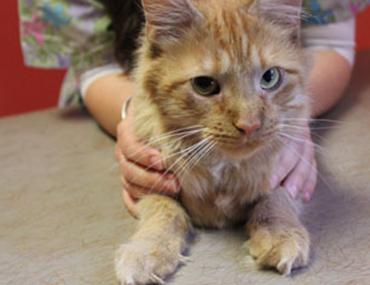Declawing cats is a very controversial issue! It’s a decision that each pet owner must make for themselves after talking with their cat's veterinarian.
Our friends at the American Animal Hospital Association (AAHA) have this to say: "The American Animal Hospital Association is opposed to the declawing of domestic cats unless all other attempts have been made to prevent the cat from using its claws destructively or when clawing presents a significant health risk for people within the household."
At Pet Health Network, we agree with AAHA. It should be a last resort. However, if a cat is posing a threat to people or other pets and declawing is the only way for a cat to stay a member of a household, we support a pet parent's right to chose this option. It's certainly better than a cat landing in a shelter and risking euthanasia.
Most importantly, remember, a declawed cat can NEVER be let outside, ever. They are defenseless.
Here are some facts to help you make the decision.
Why do people declaw?
The most common reason to declaw a cat is to keep him from being destructive (scratching furniture, woodwork, doors, etc.), After finding a guilty cat sitting in front of shredded furniture, carpet, or drapes a few times, some pet owners might be tempted by this solution.
Similarly, if a cat is constantly getting in fights with other cats in the house or scratching people, declawing is seen as a fast solution, rather than correcting the behavior through training.
On some occasions, cat owners have medical reasons of their own that prompt de-clawing. For example, people with weak immune systems, such as the elderly or chronically ill, can’t be scratched. The bacteria on a cat scratch can be dangerous for them.
Do cats need their claws?
Yes, and for several reasons. One big reason is for protection. Not only do cats use claws to swipe at predators (including dogs in the neighborhood that might chase them) in self-defense, they are also used to climb trees and escape danger.
Also, claws are an important part of cat’s anatomy. Most mammals walk on the soles of their feet, but cats are different. They are “digitigrade,” which is another way of saying that they walk on their toes. Their entire bodies are engineered for toe-walking: their backs, shoulders, paw and leg joints, muscles, tendons, and ligaments are designed to distribute a cat’s weight across its toes.
Plus, cats use their claws for many things: balance, exercise, and stretching. If a cat is stiff, it sinks its claws into a surface to create an anchor from which to stretch its back, legs, and neck. This is the only way a cat can exercise many of its back, leg, and neck muscles.
 What happens when a cat is de-clawed?
What happens when a cat is de-clawed?
The medical procedure involved in declawing a cat is called an onyectomy. It requires general anesthesia, which carries its own risks.
When a cat’s claws are removed, it is similar to cutting off the last knuckle at the end of each finger on a human hand. The claw isn’t just clipped. Actually, the whole bone is removed, including the ligaments and tendons. With five claws on each paw, feline declawing is similar to performing ten separate amputations.
After the procedure
While not every cat will experience any effects once healed from the surgery, there are some things to watch for:
- Back and joint problems. Removal of the claws means removal of a cat’s ability to stretch its its back muscles and changes the way in which the feet hit the ground. This can lead to back problems, including pain and muscle atrophy. Think of it like wearing improper shoes in humans.
- Pain. Declawing can be very painful. Some cats might get nerve damage and hemorrhage (loss of blood). And while rare, some long-term problems include re-growth of deformed claws inside the paw.
- Litter box problems. After de-clawing cats will have really tender paws and cat litter won’t feel very good to walk on. As a result, some cats may associate the litter box with pain and refuse to use the litter box. It is recommended that pet-owners provide a paper-only litter box option immediately following surgery to avoid this problem.
- Personality changes. Some cats are deeply changed by de-clawing. They can become more nervous or fearful than they were before, and this can lead to aggression. Because they cannot mark with their claws, de-clawed cats sometimes result to spraying urine instead.
- De-clawed cats can’t go outside, ever. If they do, they’ll be in danger because their first line of self-defense is now gone. In addition, they cannot climb trees to escape danger. De-clawed cats should remain in the house for the rest of their lives.
For more questions on declawing, be sure to talk with your veterinarian. While it is an option for some, it is important to be educated on the procedure before deciding it is right for you and your furry friend.
If you have any questions or concerns, you should always visit or call your veterinarian – they are your best resource to ensure the health and well-being of your pets.
The opinions and views expressed in this post are those of the author's and do not necessarily represent the beliefs, policies or positions of PetHealthNetwork.com, IDEXX Laboratories, Inc. or its affiliates and partner companies.
